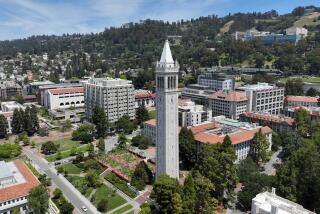When it comes to elevating livelihoods, a CSU degree is tops in California, study says

- Share via
- Cal State L.A. ranks No. 1 in California for its ability to improve economic mobility for low- and moderate-income students.
- Nine out of the top 10 schools on the list are California State University campuses.
Marco Florez knows the value of his California State University education because it changed his family’s trajectory.
His mother, Suehey Florez, immigrated to the U.S. from Mexico “not knowing a lick of English,” he said, but was able to attend Fresno State, where she earned bachelor’s and master’s degrees. She is now a special education teacher for the Tulare County Office of Education.
“One of the biggest things that transformed her life was getting that education,” Florez said.
For Florez, 22, Fresno State was an easy choice because it is “really, really affordable,” and it sets up immigrant and second-generation students for success, he said. Florez will graduate debt-free this year because of a Reserve Officers’ Training Corps scholarship he received from the U.S. Army.
“A lot of people like to think of Fresno State as a stepping stone,” he said. “But I think of it as a skyrocket.”
The Florez family’s experience exemplifies the findings of a new study that looks at an increasingly important metric in higher education: economic mobility. The California Mobility Index, created by the HEA Group and College Futures Foundation, ranks four-year California colleges based on how much low- and moderate-income students — those whose annual household income is $75,000 or less — have improved their socioeconomic standing.

No. 1? Cal State L.A.
Fresno State, meanwhile, is No. 5 on the list of 82 schools, which was released Thursday.
What’s more, nine out of the top 10 colleges in the ranking, which takes into account educational costs and former students’ earnings a decade after enrollment, are CSU campuses.
That strong showing is a sign of the system’s commitment to upward social and economic mobility at a time when many are questioning the value of a college education, said Berenecea Johnson Eanes, president of Cal State L.A.
The institutions topping the list, she said, are “intentional about social mobility and the impact they have on the community.”
What is social mobility?
Social mobility — sometimes referred to as economic mobility — is the movement of people between classes. A college education is widely seen as a key to an upward socioeconomic trajectory.
Indeed, nearly all of the top 50 schools on the CMI boosted the earnings of their low- and moderate-income students by at least $20,000 over what someone with only a high school degree would make. HEA’s analysis uses tax records from the Treasury Department to measure the earnings of former students 10 years after their enrollment.
Student debt can be a major roadblock. The CMI, which was created using U.S. Department of Education data, takes this into account, measuring the cost of education after scholarships and grants are deducted.
This is part of the reason why the top 15 colleges on the CMI are all less costly CSU campuses, save for UC Merced at No. 10 and UC Irvine at No. 12. UC Berkeley placed 24th and UCLA was 27th. Those institutions cost low- and moderate-income students less than almost every private school on the list.
The top 15 universities on the California Mobility Index
- California State University, Los Angeles
- California State University, Dominguez Hills
- California State University, Stanislaus
- California State University, Bakersfield
- California State University, Fresno
- California State University, San Bernardino
- California State University, Fullerton
- California State University, Long Beach
- California State University, Northridge
- University of California, Merced
- California State Polytechnic University, Pomona
- University of California, Irvine
- California State University, East Bay
- California State University, Sacramento
- California State University, San Marcos
Michael Itzkowitz, founder and president of HEA Group, a research and consulting company focused on college value, said that schools atop the CMI “are effective in bringing in a broad group of students, lifting them up the socioeconomic ladder and leaving them better off than the previous generation.”
All of the institutions in the CMI’s top 15 had a net cost of less than $45,000 for four years of education. Private colleges were found to be much more expensive for low- and moderate-income attendees. At No. 44 USC, the four-year net price was about $62,000; at No. 59 Pepperdine it was about $131,000, according to the study.
In part because of higher costs, schools on the lower half of the list were almost entirely private ones where it took longer for students to recoup the total costs of their education. In contrast, the CMI shows that students of the top-performing CSU schools quickly recover the costs.

Consider Cal State L.A. Data from the list shows that it takes former low- and moderate-income students from the school, on average, less than nine months to recoup their educational costs. The typical price of a four-year undergraduate education for those students is a little more than $18,000, after scholarships and grants are deducted. And, 10 years after enrollment, former students from those income levels had median annual earnings of a little more than $59,000.
Unlike many other college rankings, the CMI does not consider standardized test scores or prestige — factors that might boost private schools.
“I think there is a real angst and concern among all Americans about the cost of higher education,” said Eloy Ortiz Oakley, president of College Futures Foundation, which commissioned the CMI. “That is a real thing that policymakers and higher education leaders are going to have to contend with, and our hope is that presenting data like this will help drive that conversation.”
Cal State’s successes
The CSU is the country’s largest four-year public higher education system, with 23 campuses that graduate about 125,000 students annually.
The system is roiled by financial stress: It faces a $375-million funding cut in Gov. Gavin Newsom’s proposed 2025-26 budget. Cuts of that size would have “heartbreaking” consequences, CSU Chancellor Mildred García said in January.
California State University, already reeling from budget cuts to classes and faculty amid enrollment declines, is blasting as “unacceptable” more proposed state funding reductions.
Oakley, a former California Community Colleges chancellor and University of California regent, acknowledged the CSU system faces challenges, but said its strong showing in the CMI indicated that “investments that California has made in the Cal State University have been paying off.”
“We can see that the CSU has been carrying the largest load in terms of percentage of low-income learners and helping them get into the workforce, and doing it in a way that helps them recover the cost of their education,” he said.
Erin Pruitt, a graduate student at Cal State Bakersfield — No. 4 on the CMI — is counting on that being true.
Born and raised in Bakersfield, she got her bachelor’s degree from the university in 2023 and began working toward her master’s in business administration later that year. Multiple scholarships have helped defray the cost of her education: Pruitt, who is scheduled to graduate with her MBA in the summer, has about $21,000 in student debt. According to the research group Education Data Initiative, the average debt for an MBA graduate is about $81,000.
Pruitt, 24, said that she is pursuing some public relations jobs outside Kern County, where “salaries are significantly higher.” That, coupled with the relatively low cost of her education, has positioned her for success, she said.
“It puts me on a pathway to pay off my [student] debt, if I want to, within the first year, which is huge,” said Pruitt, Cal State Bakersfield’s student body president.
The schools atop the CMI, among them Cal State Bakersfield, don’t merely provide an “extremely affordable education” to low- and moderate-income students, Itzkowitz said. “They’re also allowing them to enter the workforce and succeed economically within just a few years.”
A world of rankings
College rankings are big business. One survey has shown that nearly 60% of high school seniors bound for college consider them, and a drop in position on one of the prominent lists can be costly, due to a decline in applications.
But rankings aren’t all the same. Alongside questions about the value of higher education are ones that probe the value of the lists.
Oakley said that mainstream college rankings have been “extremely damaging.”
“They’ve created this perception that individuals that graduate from the most selective, wealthiest institutions ... have a leg up on everybody else,” he said. “And so there’s this arms race to be more selective, more wealthy. What it does to ... the rest of Americans that go to anything from community colleges to four-year regionals to public [schools] like the UC, it skews the perception of those institutions. And so the whole ranking system is upside down.”

Although the CMI may take a different approach, other rankings also look at social mobility: U.S. News & World Report has had one since 2018 and puts out a national list and others by region.
Cal State L.A., the top school on the CMI, is tied for No. 5 on U.S. News’ social mobility ranking of universities in the West. But that analysis is focused on two factors related to Pell Grants and does not take into account economic data such as earnings.
In contrast, Itzkowitz said, the CMI highlights “institutions that not only provide a strong return on investment for low- and moderate-income students, but also enroll a large proportion of them.”
More to Read
Sign up for Essential California
The most important California stories and recommendations in your inbox every morning.
You may occasionally receive promotional content from the Los Angeles Times.












